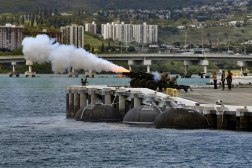Space Force taking ‘cautious approach’ to AI, cyber officer says

As the Space Force tries to reel in how guardians use large language models, the nascent and digitally focused service is still exploring how artificial intelligence can be integrated into operations.
“There are all kinds of uses for AI and machine learning that we tackle, we’re just taking a little more cautious approach right now,” Col. Zachary Warakomski, senior cyber officer at the Space Force, said Thursday during CyberScoop’s annual CyberTalks event.
In September, service leaders transmitted a memo to guardians that put a temporary hold on using generative artificial intelligence tools that leverage web-based datasets — such as ChatGPT. Despite mentions of generative AI’s potential for enhancing future operations, the service’s Chief Technology and Innovation Officer Lisa Costa cited cybersecurity and data concerns in the memo as to why the Space Force needed a pause.
The Pentagon’s new Task Force Lima — launched specifically in response to generative AI — also issued new interim guidance on Nov. 9 that advises how the department should treat the technology in the near term.
Warakomski said that moving forward, the Space Force wants to be “very clear” on how it plans to implement artificial intelligence.
One mission that Warakomski said could be improved with AI and ML is space domain awareness, “particularly when you think of the nearly 45,000 things that are on orbit, or pieces of debris that we are tracking — things of that nature. So, you’re looking at sensor tasking, pattern recognition.”
The service has been considering how these technologies could be integrated into space domain awareness operations this year, from conducting threat assessments, automating anomaly predictions and sifting through large amounts of data.
Better command-and-control ops could also be enabled by AI, particularly as the Department of Defense pivots to Joint All-Domain Command and Control (JADC2), Warakomski said. The new warfighting concept aims to connect thousands of military sensors and shooters under a single network.
“Certainly, when we look at command and control, battlefield management and the larger combined JADC2 effort across the DOD, there are all kinds of uses” for artificial intelligence, he said.






